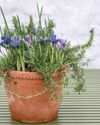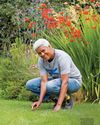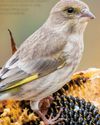
The days stretch endlessly, the weather tries hard to be good, and your garden has that magical midsummer combination of overflowing abundance, still lit with the freshness and inner vitality of late spring. Summer stretches out ahead in an unbroken festival of floral proliferation.
Well, up to a point. Disregarding what we can't control, such as the weather and the soil, a great deal of how summer unravels itself in your garden, in the months ahead, will be down to what you do in the critical fortnight or so between midsummer, 24 June, and the middle of July. In effect, it is the end of one season and the start of another, and this transition can itself be awkward. The five-week season of early summer, between Whitsun and midsummer, is the high point of the year. Everything from the beginning of January has aspired to that brief period of glory, and the garden has both the careless beauty of youth and an easy maturity. The roses are at their best, irises, poppies, lupins, foxgloves and clematis spill from the borders, and the garden has a heady sense of being at the peak of perfection and yet is filled with the promise of more to come.
But all good things come to an end. The secret and skill is to accept the change and make it work for you and your garden so that the next season, late summer, has all the possible riches and depth that only it can provide. In fact, although I love the blithe glory of May and June, I think Longmeadow actually looks best and really comes into its own in August and September. But it does not happen naturally. Do nothing and the garden slumps, hungover from June's heady excess. It is time to detox, make changes and introduce a whole new raft of plants.
This story is from the {{IssueName}} edition of {{MagazineName}}.
Start your 7-day Magzter GOLD free trial to access thousands of curated premium stories, and 9,000+ magazines and newspapers.
Already a subscriber ? Sign In
This story is from the {{IssueName}} edition of {{MagazineName}}.
Start your 7-day Magzter GOLD free trial to access thousands of curated premium stories, and 9,000+ magazines and newspapers.
Already a subscriber? Sign In

Tales from Titchmarsh
Tending the land is a rewarding if undervalued career, and it's also the best way to safeguard our future on this planet 'Same old, same old...' is a phrase that sends a shiver down my spine. Friends who have hoed the same furrow (pardon the gardening analogy) year after year in a job that pays the rent but which they do not like have my deepest sympathy.

Container of the month
Mark fresh beginnings with a hit of colour, combining bright evergreens and early risers

Boost your wellness the natural way
Gardening is good for you! Six inspiring experts reveal how getting your hands into soil, growing beneficial plants and connecting with nature can transform all aspects of your health.

Potting on a winter show PART 2
Nick Bailey banishes January blues with a sophisticated container display that's guaranteed to lift the spirits

Winter scents
Fragrant flowers can help lift the spirits on cold winter days. Monty shares his favourite plants to fill the garden with olfactory joy

Growing THE GOOD LIFE
If you've always wanted your own mini farm, let urban smallholder Sara Ward show you how

Arit's 7 deadly sins
Discover Arit Anderson's guilty gardening secrets and how you can turn your own sins into wins

Garden globetrotting
Desert Botanical Garden, Phoenix Garden globetrotting Fancy a new look for your plot or just want to try something different? Our new series about gardens around the world could be just the ticket. This month, Matt Collins reveals what captured his heart in Arizona

10 nature-led ways to feed birds
Want to give wild birds a natural boost this winter? Kate Bradbury explains how to attract a wide diversity of birds to forage within your garden and why this is so beneficial

A new plot for tasty crops
Taking on a new allotment needn't be hard work. By simply following a few easy tips you can have bumper crops in no time, just like Alessandro Vitale